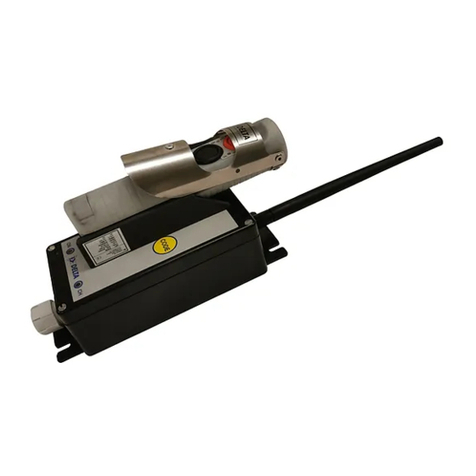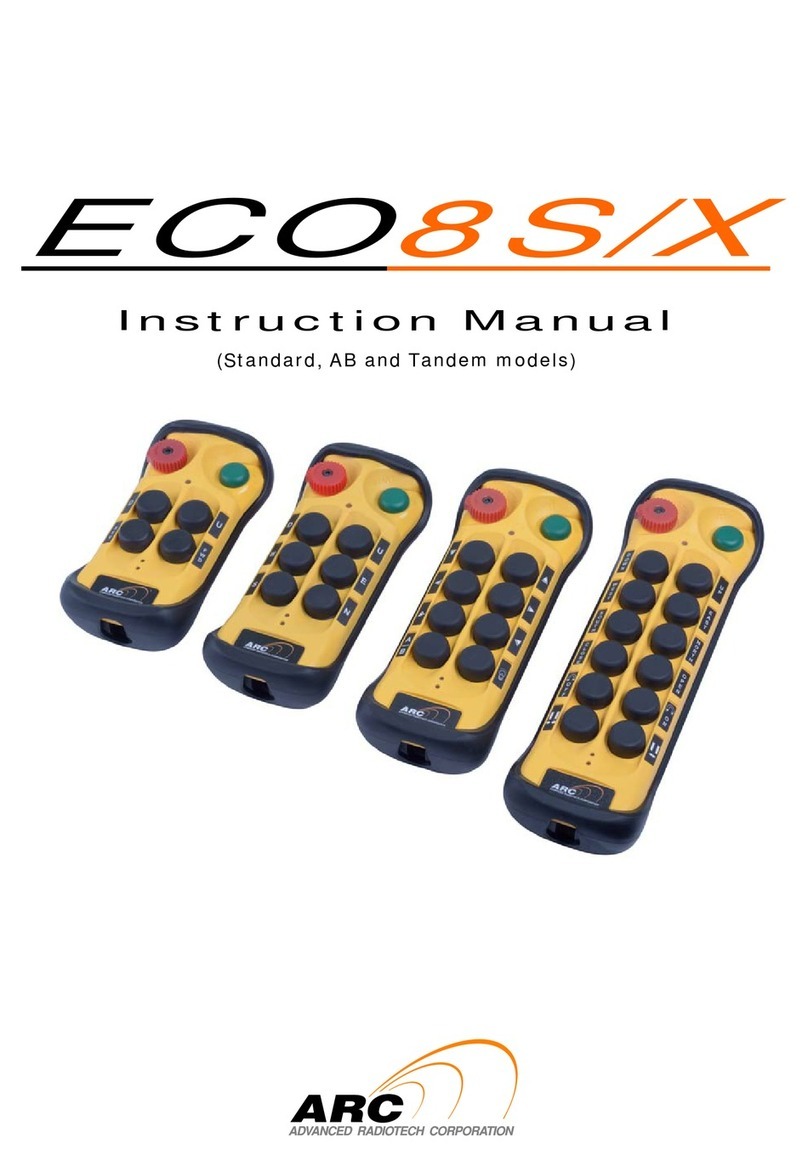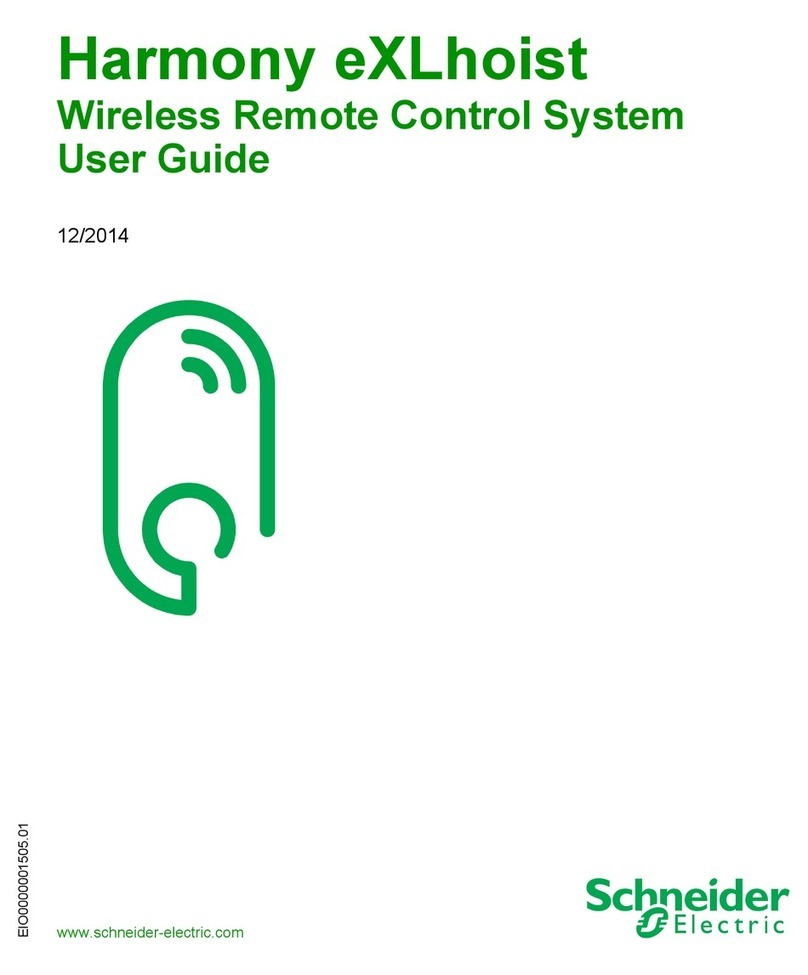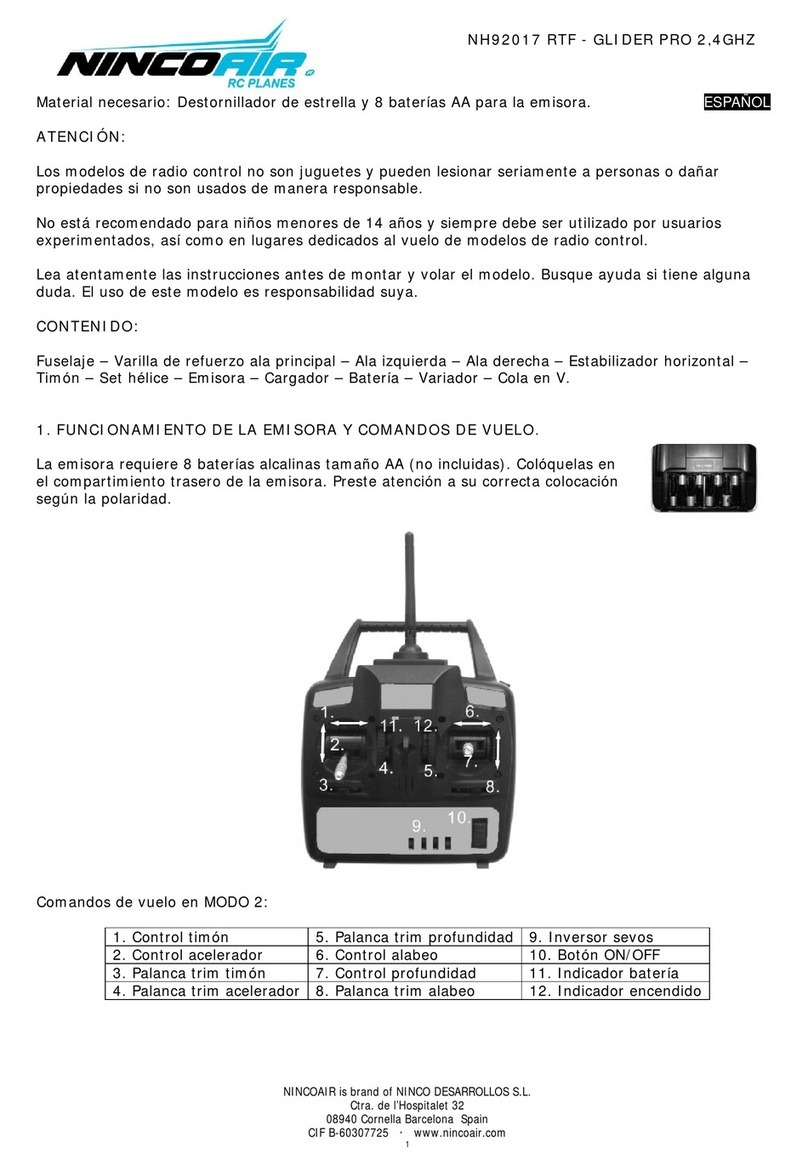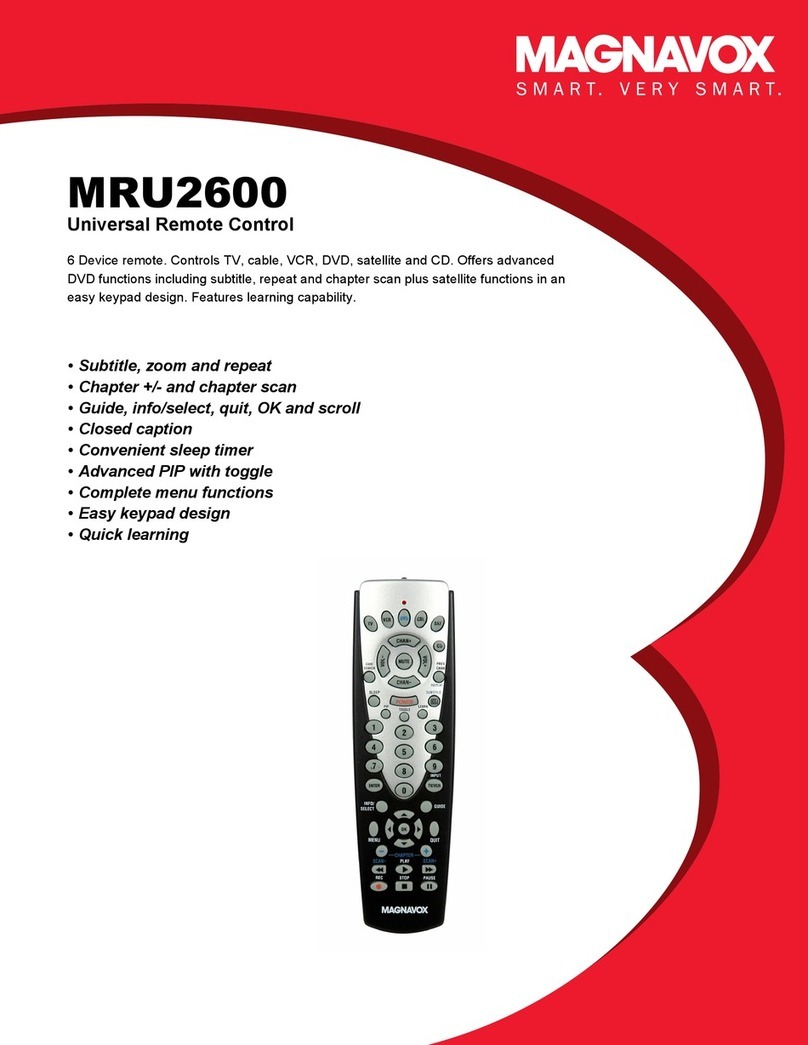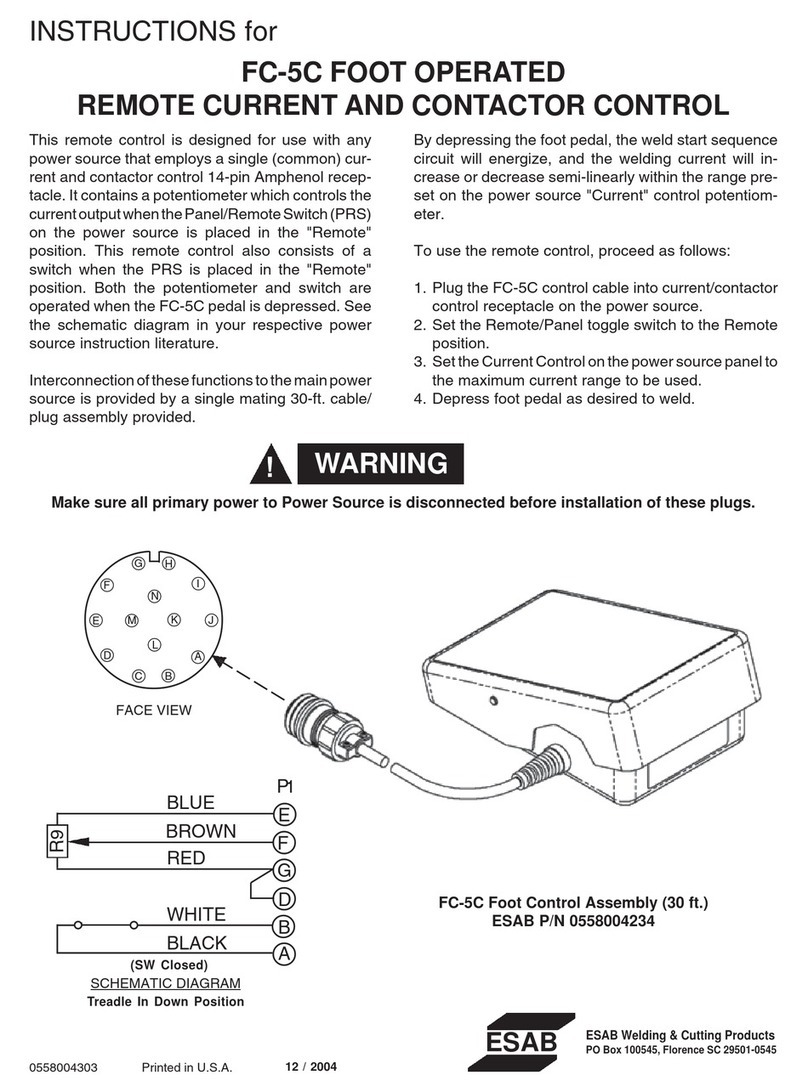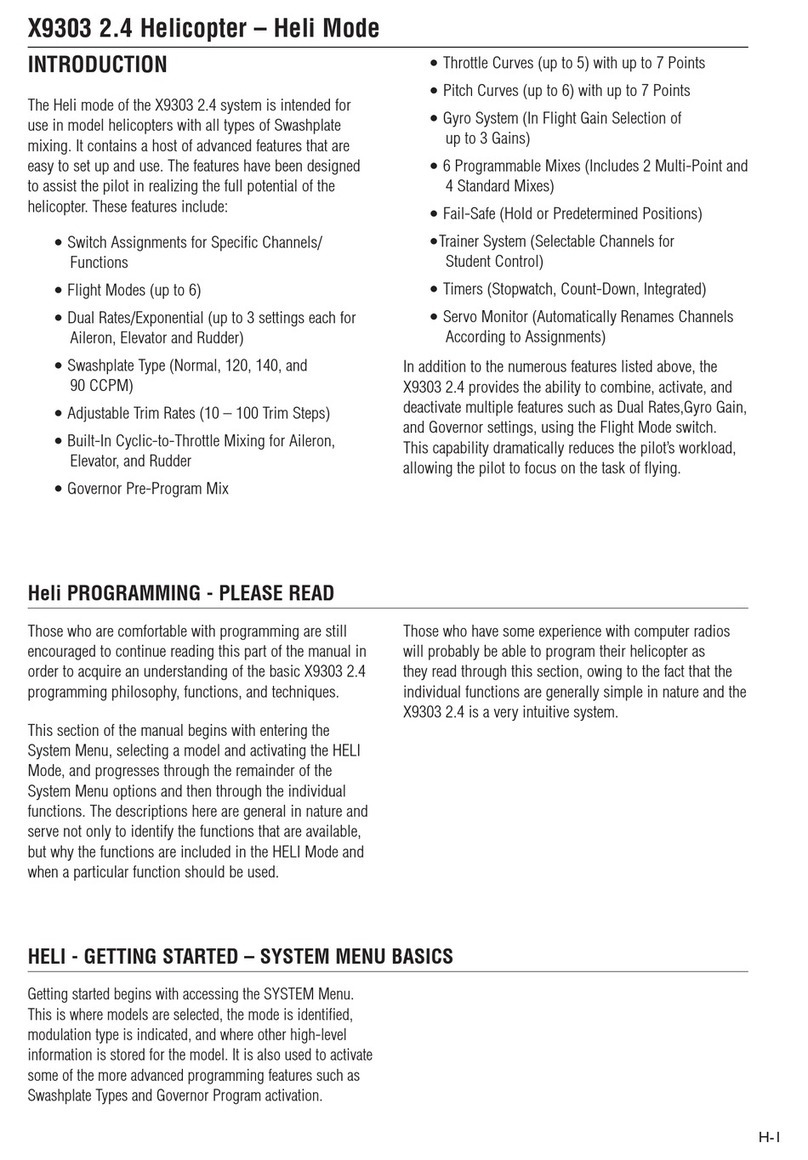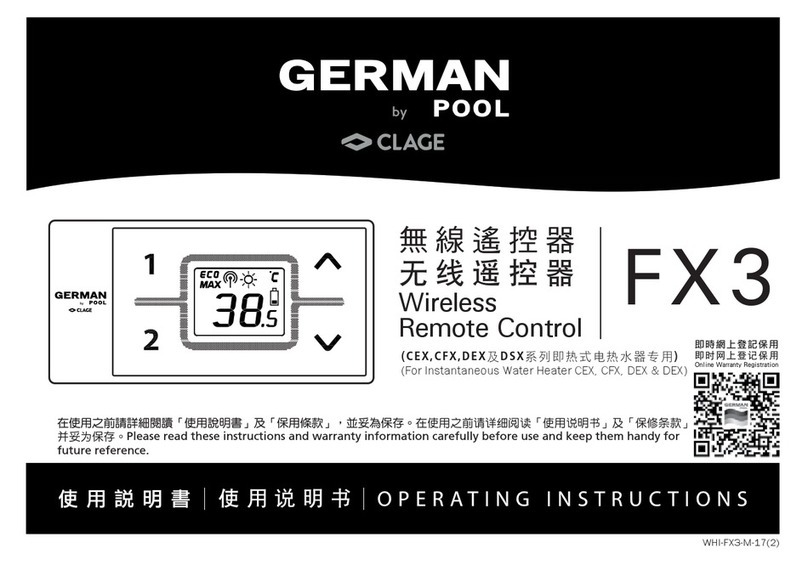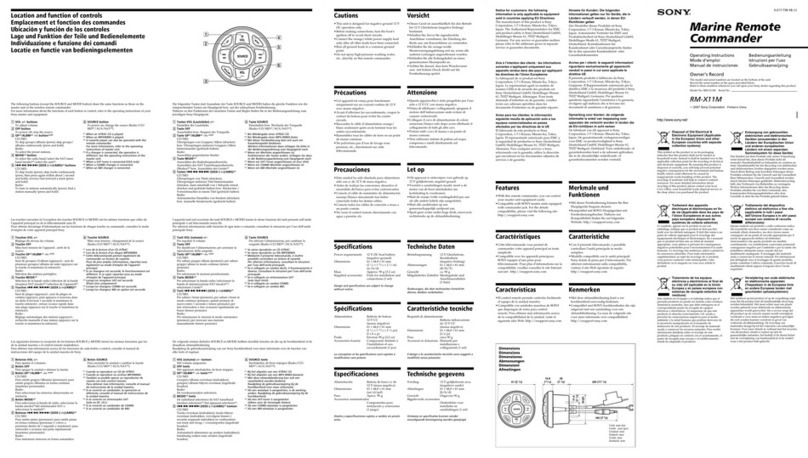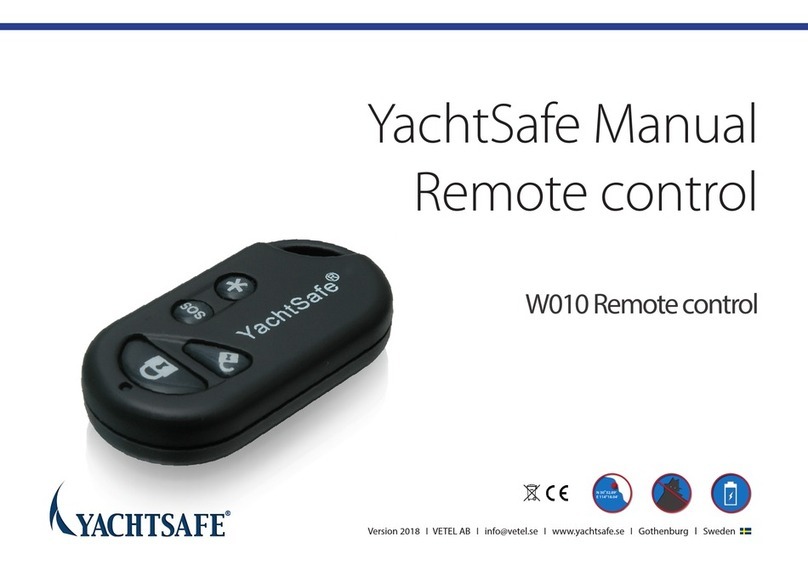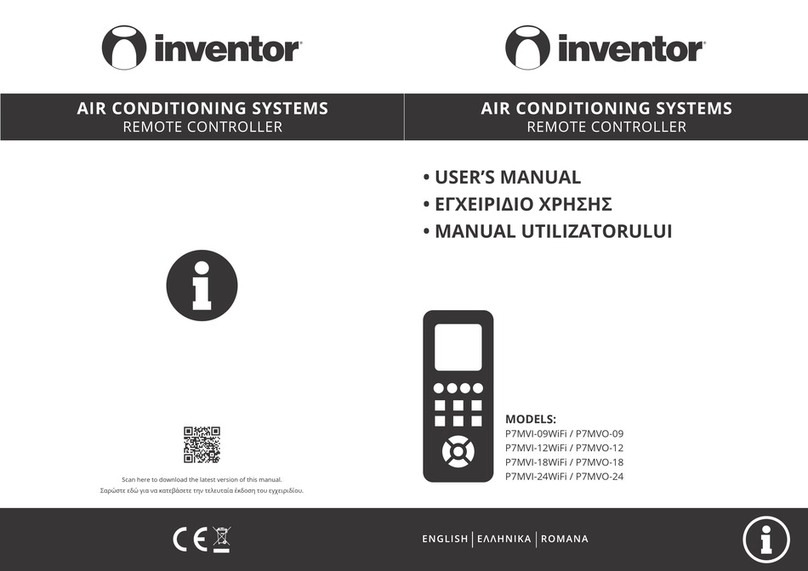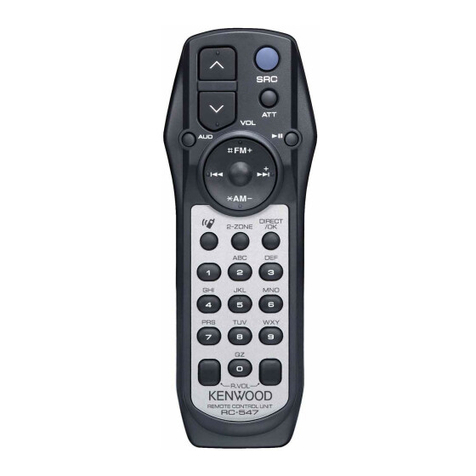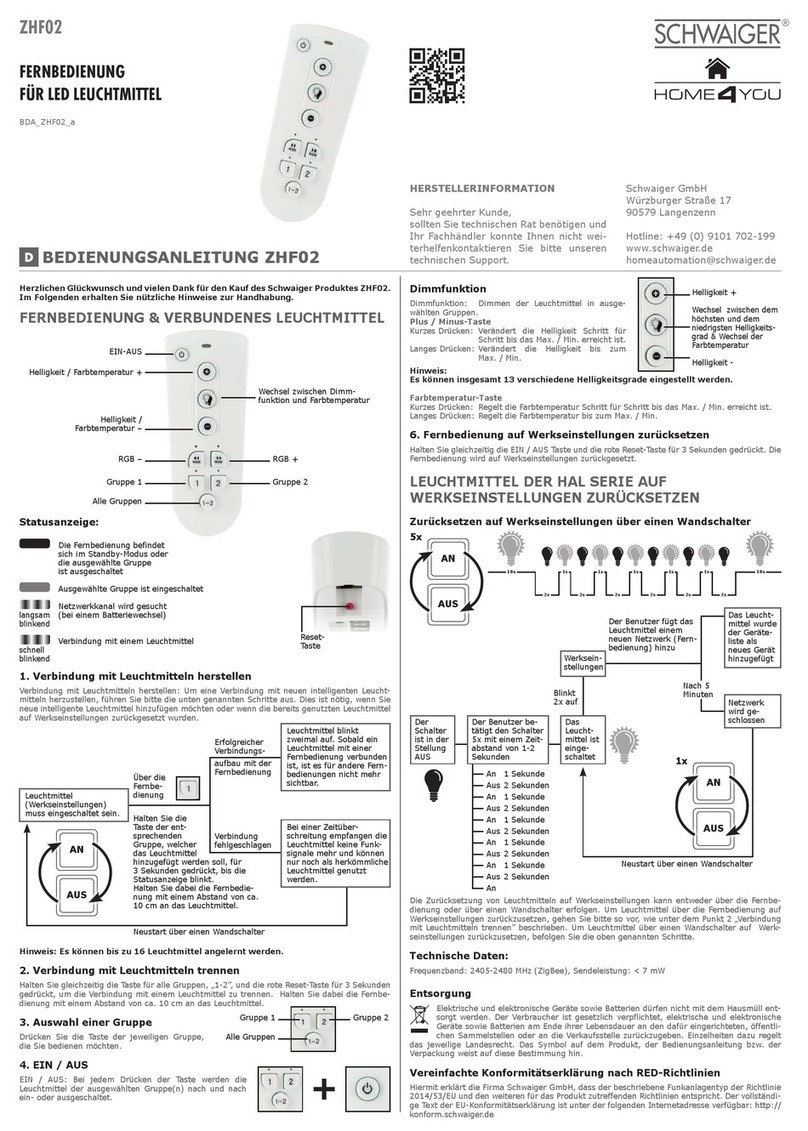Delta DE212 GLOBAL User manual

Delta RC AS Tlf. +47 33 44 83 90 Document item no: 03039
P.O. Box 1065 Web site: www.deltarc.no Revision No: D
Norway
Delta DE212
GLOBAL
System # 03040.
Wireless Deadman System
for Aero Plane Refuelling Trucks and Dispensers
For license-free, global operation.
Installation and operation Manual
- Approved transmitter

DELTA RC AS Page 1 of 33
Document no: 03039
Edition overview:
Rev.
Date
Performed
Approved
Revision description
0
26.10.2020
In progress
A
13.11.2020
ZB
Release #1
B
15.11.2020
ZB
Corrected EX certificate, section 9.1
C
11.12.2020
ZB
Added section 3.3.3
D
13.03.2021
ZB
Updated Distributors list
Content
1. INTRODUCTION............................................................................................................................................2
1.1 System highlights........................................................................................................................................2
1.2 System 03040 diagram...............................................................................................................................2
2. INSTALLATION .............................................................................................................................................3
2.1 Typical Receiver Installations...................................................................................................................3
2.2 Tank truck installation for easy access.....................................................................................................4
2.3 Receiver antenna installation....................................................................................................................4
2.4 New Antenna connector.............................................................................................................................5
2.5 Antenna for external installation..............................................................................................................5
2.6 External antenna position..........................................................................................................................6
2.7 Sector antenna solution..............................................................................................................................6
2.8 High gain sector antenna. Installation details..........................................................................................7
2.9 Receiver unit connections..........................................................................................................................8
2.10 Changing the function of the receiver unit by DIP SW3.................................................................10
2.11 DP-sensor connection.........................................................................................................................10
3. OPERATION..................................................................................................................................................11
3.1 DE212 System units..................................................................................................................................11
3.2 Functional Description.............................................................................................................................12
3.2.1 Introduction......................................................................................................................................12
3.2.2 Transmitter unit................................................................................................................................12
3.3 Receiver unit.............................................................................................................................................14
3.3.1 Hose rewind made easy with the DE212 wireless deadman ............................................................15
3.3.2 Coding the transmitter and the receiver ...........................................................................................15
3.3.3 Operational requirements.................................................................................................................15
4. SYSTEM COMPONENTS............................................................................................................................16
4.1 Standard delivery.....................................................................................................................................16
4.2 Additional equipment ..............................................................................................................................16
4.3 Spare parts................................................................................................................................................16
4.4 Receiver front unit, part identification...................................................................................................17
4.5 Transmitter part identification...............................................................................................................18
5. MAINTENANCE ...........................................................................................................................................18
5.1 Introduction..............................................................................................................................................18
5.2 Battery Recharging..................................................................................................................................19
5.3 Replacing the battery...............................................................................................................................20
6. WARRANTY CONDITIONS .......................................................................................................................22
7. DISTRIBUTORS............................................................................................................................................23
7.1 DISTRIBUTORS WITH APPROVED SERVICE SHOP....................................................................23
7.2 Distributors...............................................................................................................................................24
8. TECHNICAL DATA .....................................................................................................................................26
8.1 General......................................................................................................................................................26
8.2 Transmitter...............................................................................................................................................26
8.3 Receiver.....................................................................................................................................................27
8.4 Dimensions................................................................................................................................................28
8.4.1 Receiver with transmitter stowed.........................................................................28
8.4.2 Transmitter unit....................................................................................................29
9. CERTIFICATES............................................................................................................................................30
9.1 Transmitter Ex Certificate......................................................................................................................30
9.2 Declaration of conformity........................................................................................................................31
10. ENVIRONMENTAL INFORMATION ....................................................................................32

DELTA RC AS Page 2 of 33
Document no: 03039
1. INTRODUCTION
The DE212 Global is the third generation of the Delta wireless Deadman control system, designed
for aero plane refuelling trucks, hydrant dispensers and road trucks.
The new system is designed with the latest technology to meet future demands and for trouble-
free operation in an environment with heavy radio communication.
The previous DE212 systems can work with the new system with none or minor changes.
The hand-held Deadman transmitter is failsafe and Ex approved according to the ATEX and
IECEx regulations.
NOTE: Due to changed Ex requirements for the hand-held transmitter, the new handset is made
of a conductive grey material to prevent static electricity.
DE212 System, #03040
•Operates wireless up to approx. 30m from the refuelling vessel.
•Integrated system, all you need for a safe Deadman operation is included.
•Several Delta wireless systems can operate in the same area without disturbing each other.
•Integrated suppression of disturbing radio signals.
•Wireless operation improves efficiency and operational safety. No cable length limitations to move
around in the refuelling operation area and no cable to brake.
•No risk for unwanted activation, failsafe system.
•Flexible and modular system, easy to operate and maintain.
•Built in timer, no risk for the operator to manipulate the handheld unit.
•Integrated output for timer warning light and beeper.
•Emergency stop is included.
1.1 System highlights
•External override functions.
•Integrated interlock, ensure safe operation.
•Long battery capacity, more than 12 hours. Battery lifetime is more than 3 years.
•Receiver with integrated intelligent charger.
•Unique coding system between handheld unit and receiver, easy maintenance.
1.2 System 03040 diagram
System Diagram (Not to scale)
Hose Reel
External Stop
External Override
DP Warning light
Interlock
DP Sensor
DP Reset/Override
DP Output
12/24VDC
Emergency STOP
Fuel Valve control
Warning Buzzer
Warning Light

DELTA RC AS Page 3 of 33
Document no: 03039
2. INSTALLATION
2.1 Typical Receiver Installations
The receiver unit is normally installed in the driver’s
cabin, out of EX defined area.
Before installing the receiver, it must be carefully
considered the position inside the drivers cabin.
On dispensers the receiver is often installed in the
front of the cabin, using the standard antenna, like on
photo 2 and 3.
In cabins with windows on all 4 sides, it is a good
possibility for sufficient radio signal unless if the
windows are treated with materials to reduce direct
sunshine, this may also reduce the radio signals.
If the receiver is installed in a lover position, like on
photo 1, it is recommended to use the external
antenna solution.
At the receiver front panel is the recharging and
stow station for the transmitter. When stowed the
integrated battery is automatically recharged. It is
important that the installation of the receiver is done
for easy access for the driver, in order to stow the
transmitter for charging after every refuelling
operation. The orientation of the receiver is not
critical regarding the antenna. It must however be
considered that a lot of metal close to the antenna
could reduce the radio signal, and reduce operational
range and also the operation stability.
On photo 2 and 3 the antenna is free to receive in all
directions.
If an external antenna must be used, several options
are available. See section 2.3 to 2.8.
The receiver must have connection to power
supply/battery, 12 or 24VDC, the fuel valve,
controlling the fuel filling of the aircraft and the
warning indicting lamps.
NOTE: When installing the receiver unit, it should
be considered to installed it in a place with
temperature within 0 and +50ºC. This is vital since
the transmitter battery, NiMH does not charge
properly outside this temperature range.
If the temperature is outside these limits, it is
recommended to use a mains transmitter charger,
CH300 in a room with controlled temperature. See
section 5.2.
1
2
3

DELTA RC AS Page 4 of 33
Document no: 03039
2.2 Tank truck installation for easy access
Figure 2.2 shows the position of the receiver in a tank
truck for easy access. Receiver installed in this
position requires normally external antenna. See
section 2.5
2.3 Receiver antenna installation
Introduction
During the last years, the wireless communication has increased very much. In general this does
not influence the data communication of the DE212. However the expansion of the 4G network
has given several new Base stations to improve the 4G service for travellers entering or leaving
the aircrafts at the gates.
These 4G Base stations operates at a different frequency than the DE212, but at short range the
much higher power can disturb the receiver input so much that the operation stability is reduced.
In order to solve this challenge, Delta RC has done research and several tests at busy airports and
have introduced at the DE212 #03040 system:
a) A more selective 2,4GHz receiver module. Integrated in the receiver unit.
b) A new and more selective standard antenna on top of the receiver
c) A new and more selective antenna for external installation
d) A new sector antenna solution for extreme and heavy radio disturbances.
With this solutions, Delta RC has found a safe and practical way to deal with disturbing radio
signals.
In most cases, the solution a) will solve the disturbance problem and is standard for the 03040
model.
In cases where the base station is very close to the gate, 100 to 300m the sector antenna solution
may be needed.
Also note that the disturbance problem is not a static situation. The wireless network is constantly
expanded or changed. However the new development with 5G is not expected to cause problems.
The reason is that new network normally are at higher frequencies than the 2,4GHz.

DELTA RC AS Page 5 of 33
Document no: 03039
2.4 New Antenna connector.
The DE212 set, item 03040, has a brand new receiver.
Please note that this unit, RX212 has a new antenna connector. The new connector, is
type RP-SMA does not fit to the previous FME connector. This mean that old
installations with FME connector must also change the antenna if an upgrade of the
complete receiver unit is done.
The new RP-SMA connector The previous FME connector
Valid from August 2020, at model 03040 Discontinued on standard deliveries
2.5 Antenna for external installation
The DE212 system is always delivered with a standard antenna, for installation direct
on the antenna connector on top of the receiver unit in the drivers cab.
However if the standard solution does not give sufficient range and operational
stability, an external antenna can be the solution.
Antenna, art.no 12396 have 360°receiving pattern. For outdoor installation.
Antenna head
Antenna cable, 3m long
See section 4, for ordering information.

DELTA RC AS Page 6 of 33
Document no: 03039
2.6 External antenna position
Figure 2.7 shows the position of the external 360°antenna behind the drivers cab.
This position gives reduced sensitivity at the front part of the vehicle but good
sensitivity behind the cab, where the operator normally is working.
In many cases the position of the external antenna can just be on top of the drivers
cabin, or even inside the drivers cabin close to the rear window.
2.7 Sector antenna solution
In some areas of the airport the disturbing signals can be extremely strong, and a
special antenna solution is needed. After several tests at different airports, Delta
can offer a solution that is easy to install and effectively reduces the disturbing
wireless signals and hence give the needed operational stability.
Sector antenna with installation bracket.
As shown at the photos, the sector antenna is installed at the working side of the
vehicle and is tilted about 20°down. This is important, when tilted down it will
normally not “see” the surrounding 4G base stations but will keep a good connection
with the fuelling operator at the tarmac.

DELTA RC AS Page 7 of 33
Document no: 03039
2.8 High gain sector antenna. Installation details.
See section 4, for article numbers and order information for spare parts and optional
equipment.
Note: Antenna and installation bracket may be adjusted due to developments.
Art.no 11682
Sector antenna
Art.no 03017
Antenna bracket
For mast and wall
110° turnable
20° fixed tilt down
Art.no 12380
Connecting cable 5m
With connectors
Wall mount
Mast mount
Antenna face

DELTA RC AS Page 8 of 33
Document no: 03039
2.9 Receiver unit connections
The new receiver mainboard with the added radio communication board, the HF-
module.
All external connections to the Deadman system are in the receiver unit.
The in-and output signals are based on SW version: 02907.
Connecting the receiver to the power source of the vehicle must be carefully considered.
Normally the transmitter is stowed at the receiver for recharging the integrated battery.
If the vehicle is left for a longer period out of service, the transmitter battery will have
reduced capacity. It should therefore be considered to connect the receiver directly to
the vehicle battery. This will keep the battery capacity at a good level and ready for
operation.
Note: The P3 connections are all input signals. All 4 inputs are prepared for connections to
sensors or switches located in Ex-zone 1.
See section 8 for more technical information. Ex certification: Pending.
Abbreviations used in this document:
TX= transmitter, the handheld mobile unit controlling the receiver unit.
RX= receiver, the stationary unit located at the refuelling vehicle receiving radio signals from the
transmitter
Receiver connections at P1 and functional selection by software-version; 02907
Antenna connector
HF-module
1. TIMER BEEPER OUTPUT
2. TIMER WARNING OUTPUT
3. HOSE REEL CONTROL OUTPUT
4. DEADMAN OUTPUT
5. STOP OUTPUT
6. INTERLOCK OUTPUT
7. INPUT VOLTAGE, MINUS
8. INPUT VOLTAGE, PLUS+ 12/24V
9. OUTPUT F7, FOR FUTURE EXP.
10. INPUT, DP RESET/OVERRIDE
Receiver mainboard
1
2
3
4
5
6
7
8
9
10
Receiver connector P1
5
4
3
2
1
Receiver connector P3
See note below
1. EXTERNAL OVERRIDE INPUT
2. DP SENSOR INPUT
3. EXTERNAL STOP INPUT
4. WIRED DEADMAN INPUT
5. GND
SW3, DIP Switch Function select
(See chapter 2.10)
1
2
3
4
5
1. OUTPUT F8, FOR FUTURE EXP.
2. OUTPUT F9, FOR FUTURE EXP.
3. GND
4. DP OUTPUT, (DP TO HIGH)
5. DP WARNING LIGHT OUTPUT
Receiver connector P2
Input voltage fuse; F2 Auto fuse 5A 32VDC Blade Mini

DELTA RC AS Page 9 of 33
Document no: 03039
Connector
P1 in
receiver
Function
Comments
Select SW3, see section 2.9
1
Output; buzzer or flash-light timer warning
Output is high during the last 30 sec of the timer
period. To give an extra warning by sound or light.
2
Output; Timer warning
SW3-1 Deadman timer
Active high when deadman output is active. When
30 sec. remains of the max 2min. period, the output
goes OFF/ON with 1sec. intervals until the period is
restarted or it times out and stops the fuelling.
3
Output; Extra function, for
hose reel or pump speed control
SW3-2: Extra function.
Simultaneous or no simultaneous operation with the
Deadman function.
ON = Simultaneous operation
4
Deadman output
Active high when deadman is activated.
Timer limit without restarting is 120sec/2min.
5
STOP
Ouput; Normally ON= high output
Goes low when STOP at transmitter is active
Output for remote emergency stop of External units
6
Output; High output when transmitter is
stowed for charging
Output for interlock of vehicle operation, to force
operator to stow the transmitter for charging.
7
Minus-pole for input voltage
GND, normally connected to chassis.
8
Plus-pole for input voltage
Voltage range: 11-27VDC
9
Output, F7
For future expansions.
10
Input signal; DP Reset / Override
Low input, less than 0,3V resets DP and override the
fuelling stop.
Note: High outputs are 12 or 24V when activated, same as the receiver supplied voltage.
Receiver connections, connector P3:
Functions installed with receiver software program: 02907
Conn.
P3
Functional description
Functional settings
1
External override
The Deadman function is active as long as this input
is low, connected to GND
SW3-3 : External override
ON= Ext. override enabled.
OFF=Ext. override disabled
2
DP sensor input
SW3-4, see section 2.10
3
External STOP.
Input signal. Stops all functions in the receiver when
connected to GND
This function is always enabled
4
Wired Deadman input, ON/OFF deadman or
Delta Failsafe
SW3-5. Optional. Contact
distributor or Producer.
5
GND, ground or common terminal.
Same as P1-7 and P2-3
NOTES:
•The receiver works with supply voltage 11 to 35 V DC. All outputs give supply voltage out when
activated.
•NOTE: Input voltage above 35V, will shut down the receiver.
•The timer warning output operates as follows: when the Deadman function is activated, the time
warning output also go active, supplying 12/24V out. When 30 seconds are left of the 2 min. time
period, the standard period, the output change from a steady output, to an off/on signal during the last
30 seconds of the time period. The output is intended for connection to an indicating lamp, visible for
the operator. The on/off flashing lamp is intended to warn the operator to restart the time period.

DELTA RC AS Page 10 of 33
Document no: 03039
ON
2.10 Changing the function of the receiver unit by DIP SW3.
The function of the receiver unit can be changed according to operational requirements.
The following can be changed:
•SW3-1: Timed or no timed Deadman. ON is activated.
With timer OFF, the deadman function will work as a normal ON-OFF switch with no time delay.
•SW3-2: Simultaneous or no simultaneous operation of the extra function at the handheld
transmitter.
•SW3-3: External override, enabled or disabled.
•SW3-4: Differential Pressure Switch/ DP input at P3-2 enabled or disabled.
•SW3-5: Wired Deadman input, P3-4. ON/OFF Deadman or Faisafe Delta Deadman
Standard factory settings of SW3 switches:
Default settings are shown
SW3
Function
Comments
1
Deadman timer max 2min.
In OFF, instant operation, no
delays
ON=Active Default
OFF= No timer
2
Function 2:
OFF=Can not work
simultaneous with the
Deadman function
ON= Can work simultaneous
with the Deadman function
OFF=Default
For Hose reel operation.
ON: for pump speed
control
3
Deadman external override
OFF= Default, not active
4
DP sensor input
OFF= Default, not active
ON= DP sensor is read
5
Wired deadman input
OFF=ON/OFF deadman switch
ON= Delta Failsafe wired
deadman
OFF=Default
Optional
6
TBD
OFF= Default
7
TBD
OFF= Default
8
TBD
OFF= Default
To store the DIP SW3 settings in the receiver:
1. Set the function switch, SW3 to the desired positions.
2. Take out the fuse, F2 or switch OFF the power input.
3. Press the yellow CODE-button on the receiver front and keep it pressed. Replace the fuse, or
switch ON the power of the receiver. Watch the green ON LED, keep the CODE-button pressed
until the green ON LED turns on. Normally the time for reading the new settings of the SW3,
takes about 3 secs.
When the ON is green, it indicates that the new settings of SW3 are successfully stored, and
the receiver is ready to operate.
2.11 DP-sensor connection
The receiver is prepared for connection of a DP-sensor, for Differential Pressure
protection. This sensor can be of different types.

DELTA RC AS Page 11 of 33
Document no: 03039
3. OPERATION
3.1 DE212 System units
The 03040 system includes the following parts:
Standard:
Portable and ergonomic transmitter, with integrated battery and antenna.
Receiver for fixed installation, with antenna connector, and cable gland for connection cable.
Receiver antenna for installation on top of the receiver. RP-SMA connector
Optional:
Antenna for external installation, omnidirectional, 360°with 3m cable.
Sector antenna for installations with heavy radio disturbances
Delta CH300, 115/ 230V mains-powered battery charger for transmitter,
See section 4 for ordering information.
Receiver
Transmitter
Transmitter stowage
and Charging station
Cable inlet
Standard Antenna

DELTA RC AS Page 12 of 33
Document no: 03039
3.2 Functional Description
3.2.1 Introduction
The wireless connection between the handheld deadman control, the Transmitter unit and the
control unit, the Receiver in the vehicle, gives the operator better working conditions, improved
efficiency and a significant higher level of safety.
The limiting factor of a wired deadman is obvious since the cable length is normally 14m long
and reduces the operators ability to freely check around the vehicle and the fuelling panel under
the Aircraft fuselage.
The safety level is increased significantly by 3 factors:
a) The handheld deadman control is Ex-approved for Zone 1 operation.
b) Failsafe design. Very low risk for causing unwanted accident.
c) With the STOP button on the handheld control, the operator can remotely and instantly
STOP the fuelling process in case of an emergency.
3.2.2 Transmitter unit
The transmitter is controlled by a small microprocessor. It is always turned on in a standby
mode, and will therefore discharge the battery after 3 to 5 months, depending on the state of
the battery, if it is not recharged during that period of time.
A fully charged battery has a capacity of at least 12 hours of continues operation. The long
operating time is made possible by the Delta timeshare transmission system, WTT. Using
transmitting power only in very short periods.
The battery is charged via the two stainless steel contacts at the back side of the transmitter.
The transmitter must be charged on the charge station on the receiver front panel, or on a
mains battery charger, CH300 delivered by Delta RC. The transmitter charging connections,
are protected against discharging of the built-in battery.
The battery lifetime is normally 2-4 years.
The Deadman push-button is activated by a stainless steel handle as long as it is pressed.
Handle
STOP Button
Extra function, Hose reel (or pump RPM) control
Deadman button
Transmitting/TX LED
Low Battery/LB LED
Battery module
Spiral spring
operating the
Deadman button

DELTA RC AS Page 13 of 33
Document no: 03039
The radio signal activates an output circuit in the receiver, supplying the output or the
Deadman function on the receiver’s connector. This is the output for the Deadman button for
refuelling.
When the handle is released, the Deadman output is off after max 1,5 seconds.
If the STOP-button is pressed, all function stops instantly and the normally operated STOP
output, used for emergency stop, in the receiver goes off as long as the button is pressed.
The third push-button called, extra function, is normally used for hose reel in control or this
may also control pump RPM control. Note that this function is on the standard delivery not
possible to operate simultaneously with the Deadman function. For simultaneously operation,
the receiver must be reconfigured. See section 2.10.
There are two light diodes, LED’s on the front panel marked “TX” and “LB”.
The TX LED is yellow and is blinking when the transmission is active, and will continue to blink
for a short time after the operative push-button is released, sending an active stop signal to
the receiver.
The LB LED is a dual function LED. It flashes with a red light when the battery is at low
capacity, and should be recharged. The transmitter can be used for about 15 min. after the
red LED is turned on. When the TX LED is dark, turned off, the transmitter has stopped
transmitting and the battery must be recharged.
During normal operation, the LB LED is flashing green, indication that the connection with the
receiver is good. When the LB Green stops flashing, the receiver signal is weaker and the
connection to the receiver may be lost if the distance increases.
The LB red LED is active only when the transmitter is activated. By pressing the STOP-
button, the battery can be tested during active transmission.
The STOP button turns off the functions in the transmitter and sends an active STOP, turning
instantly off all the functions activated in the receiver. If the Deadman button is stuck, and
the STOP-button is pressed, the transmitter cannot be operated again before the damaged
button or switch is repaired or changed.
Transmitter operation in low temperatures, lower than -20C can be performed, but not for a
long period of time. The transmitter must be warmed and charged at temperatures higher
than 0C when not in use.
Under normal operation, the battery lifetime is 2-4 years.
New solution for transmitter moving handle and strap connection.
01958, Delta strap
01958, Delta strap for transmitter

DELTA RC AS Page 14 of 33
Document no: 03039
3.3 Receiver unit
NOTE: Drawings and Photos may differ slightly from reality.
The receiver front has a charging station for the transmitter unit, two LED indicators and one
push button marked “CODE”.
The energy charged to the battery, is calculated according to the time the transmitter has
been used.
This will ensure high capacity and reduced overcharging of the battery.
The CH LED has three stages when the transmitter is placed to charge:
1: CH is dark. No action.
2: CH burns continues. Full charge current.
3: CH flashes. Indicates trickle charging, battery is full according to the last duration of use.
The green LED, marked ON, indicates that a correct voltage is supplied and the receiver is
ready for operation. When coding the receiver and transmitter, this green LED flashes three
times when the code is accepted and stored in the receiver.
When the receiver is in operation, receiving an accepted telegram from transmitter, the
yellow CH LED is flashing rapidly.
Antenna
Charge contacts
Right
Left
Charge station
ON, Green light
CODE button
CH, Charge, Yellow light

DELTA RC AS Page 15 of 33
Document no: 03039
3.3.1 Hose rewind made easy with the DE212 wireless deadman
The DE212 system has an extra function. This can be used for additional functions, like hose
rewind. This function is implemented in the system so it can NOT be activated simultaneously
with the Deadman function, That means that when refuelling, the Hose rewind function is
de-activated and can not start the rewind of the fuelling hose and Nozzle.
Remote rewind makes the operation goes faster with better control and reduces the physical stress
of the operator and the hose and Nozzle. The operator walks back to the vehicle carrying the
Nozzle, see photo.
3.3.2 Coding the transmitter and the receiver
In order to make the receiver execute a function, the code in the handheld unit, the transmitter, must
be transmitted to the receiver and correspond with the code stored in the receiver.
The DE212 system has 65.536 different codes available. Each code and serial number of the unit is
logged by the producer and used only once.
The transmitter is hard-coded from the factory, while the receiver must be coded by the user before the
system goes into normal service.
Coding:
Press the yellow CODE button on the receiver front panel and keep it pressed simultaneously with the
red transmitter STOP button until the Green ON-LED flashes three times, then release both buttons.
The three flashes indicates that the code is stored. The system is now ready to operate. The old code
is erased and the new code is stored in the receiver even if the power is turned off.
Erasing the code:
The stored code in the receiver is erased by pressing first the Deadman button on the transmitter then
the CODE-button in the receiver, after some seconds, the green ON flashes 5 times, and the code is
erased. To maintain normal operation again, the receiver must be re-coded.
3.3.3 Operational requirements
Please observe the following. This is mandatory to maintain a safe operation.

DELTA RC AS Page 16 of 33
Document no: 03039
1. The instruction manual has to be observed.
2. The permissible ambient temperature range during operation is -20 C up to 50 °C.
3. The permissible ambient temperature range during charging is 0 °C up to 50 C.
4. The charging of the deadman transmitter type TX212-2S GLOBAL DM (02705) is only allowed
with the associated charger Receiver RX212 Global, Order Number 03038, or with the
Transmitter charger CH300-2, 11OV/230VAC, Order Number 03033.
5. The battery pack has to be exchanged outside any potential explosive atmosphere. The
battery pack shall be exchanged only with the battery pack 02465.
4. SYSTEM COMPONENTS
4.1 Standard delivery
Order number
Item Description
03040
Remote Control DE212 Global
Complete set, containing: Transmitter 02705, Receiver 03038 and Antenna 12376
Note: The standard delivery of a system has these main functions:
•Timer controlled deadman. Running for 2 min. continuously. Warning light, or beeper
tells operator 30 sec. before end of the 2 min. Restart timer by a short release of the
deadman function.
•Emergency STOP. High output signal as long as power is on.
The output is switched to OFF= low, as long as the STOP button on the transmitter is
pressed.
•External Override. An input signal from an external unit, which overrides the
deadman handset. Emergency STOP on the handset is still active, even if external
override is used.
•An interlock output signal when the transmitter is placed in the charge station on the
receiver front. Can be used to lock the vehicle from moving after refuelling.
See section 2.9 for more information.
If the installation require more than the standard delivery, the following are
available:
4.2 Additional equipment
4.3 Spare parts
The following spare parts are available:
Order number
Item description
01855
PCB TX212-2S Global ATEX/IECEx certified
Order number
Item description
02705
Transmitter TX212-2S Global. ATEX/IECEx certified
03038
Receiver RX212 Global
03033
Charger CH300-2 110-230VAC. EU, TX212
12396
Antenna WiFi 2,4GHz 3dBi, RP-SMA(m) 3m cable
11682
High gain Sector antenna, without cable.
03017
Tilted and turnable installation bracket set for Sector antenna. For Mast and Wall
12380
Cable for connection of sector antenna, 5m long with connectors
02976
High gain Sector antenna set. Including 11682, 12380 and 03017
01958
Neck Strap, Blue Delta

DELTA RC AS Page 17 of 33
Document no: 03039
02704
Housing TX212-2S Global, ATEX/IECEx certified
02465
Battery module TX212 Global, ATEX/IECEx certified
02994
PCB RX212 Global mainboard G2
03014
PCB RX212 Global HF-module VX
01760
Housing RX212 Global Front
02999
Housing RX212 Global Bottom.
12375
Pigtail Cable RG316, 15cm. RP-SMA(f)- MCX(m) angle
12376
Antenna WiFi 2,4GHz 5dBi RP-SMA(m) 20cm long
01752
Charge contact RXA Global Left
02063
Charge contact RXA Global Right
02886
Spring Kit TX212
02885
Rubber button Set
4.4 Receiver front unit, part identification.
Main connector P1
Input voltage fuse
Auto fuse 5A
Antenna
connector
Connector P3
(If applicable)
HF module
connectors
SW3
Function select
Main printed circuit board, PCB
# 02994
and PCB ID sticker
HF-module
03014
Connector P2
(if applicable)
Transmitter
Charge station
connector
HF module
# 03014

DELTA RC AS Page 18 of 33
Document no: 03039
4.5 Transmitter part identification
5. MAINTENANCE
5.1 Introduction
It is important that the operator keeps the transmitter battery charged so that the system always
are ready for operation. After a refuelling operation, always replace the transmitter in the charger
at the receiver front. This will secure recharge of correct energy to the battery according to last
operation.
If the transmitter is left at storage for more than 4 months with the battery connected, the battery
will be at very low energy and may not be able to recharge. If so the battery module must be
replaced.
The DE212 system should be kept as clean as possible at all times, this is vital for the transmitter.
Repair work
The transmitter, TX212 is an Ex, ATEX/IECExclassified unit, which can be usedin hazard areas,
zone 1. This classification needs a special attention from the owner and user.
The TX212 design, both the electronic- and the mechanical part, is designed and controlled to
meet the Ex requirements. To keep the classification, and the security, the TX212 unit should be
inspected regularly by the user.
In case of a damage of the TX212, it should be taken out of service send for repair to Delta RC
AS or an appointed service station.
However the following parts can be replaced by a local skilled mechanic:
a) change the battery unit. See also section 5.3
b) change the spiral spring on moving handle
c) replace rubber buttons
Battery module
#02465
Printed Circuit Board,
#01855
Battery module connector, P3
Charge connector,
P2
Transmitter housing
#02704
Battery and charge connectors connected.
Printed circuit board shown partly inserted in
the housing.
During assembly, carefully make sure that
the O-ring and wires are not jammed
between the battery module and housing.
O-ring
Spiral spring
# 02886
Rubber button set
#02885
Front Cover
#01455

DELTA RC AS Page 19 of 33
Document no: 03039
NB: Due to Certification requirements point d) and e) are for distributers with service
certification only
d) change the PCB
e) change the complete housing with the moving handle
Any mechanical or soldering work beyond this is not allowed.
Replacing the transmitter housing will require a new housing from Delta RC. In order to follow
the strict requirements from the EX-certification, a new housing will require a new unit label, and
this can only be issued if Delta RC gets a photo of the label of the defective housing. If this is not
possible, the new housing must have a a new unit label. In addition Delta RC need the ser.no of
the transmitter PCB and battery unit. This must be registered in Delta’s database for TX212.
All services and repairs of the TX212 unit, will be stored at the repair station, and/or by Delta RC
AS store. In case of an accident, it is possible to track the “history” of the unit.
Do not operate a TX212 which has a damaged housing.
A damaged unit must be taken out of service, and returned for repair.
Damages like cracks or holes in the cabinet plastic or rubber, are a safety risk
and must be repaired before further use.
Do not open the TX212 housing except when replacing the battery module.
5.2 Battery Recharging
1. Before the transmitter is used for the first time, it should be recharged with continues charging for
3 hours. Place the transmitter in the charger on the receiver. Wait till the CH lamp start flashing,
press the CODE button on the receiver for some seconds, and the CH lamp will be lit with a constant
yellow light. constantly, indicating that the transmitter battery is charged with maximum current. If
the transmitter is left in the charger, this state will last for 3 hours leaving a completely fully
charged battery. Note, if the battery is not completely empty, two hours charging is normally
sufficient to start operation. Do not repeat the 3-hour full charging unless the red LB lamp on the
transmitter is flashing.
2. When the transmitter is placed on the receiver charge station, the transmitter battery will be
recharged according to the duration the transmitter has been used. The recharging will replace the
used battery energy actually used during operation. This type of charging will secure maximum
battery capacity and lifetime. Every time the transmitter is placed in the charger, it charges for 30
IMPORTANT NOTE:
Any unauthorized attempted repair, modification or other alterations of the product without
prior written permission from Delta RC AS will render both ATEX/IECEx approvals and warranties
invalid, and the responsible operator/owner will be held liable for any damages or injuries which
may occur.
Delta RC AS shall not be liable for reimbursements, claims and damages that may result from the
unauthorized repair, modifications or alterations of the product.
Other manuals for DE212 GLOBAL
3
This manual suits for next models
1
Table of contents
Other Delta Remote Control manuals
